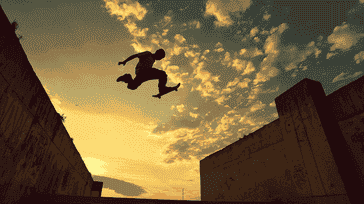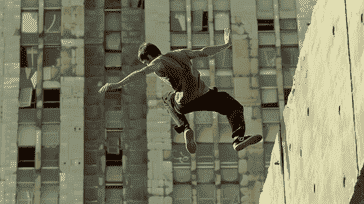The Art of Movement: Exploring the World of Parkour

Introduction to Parkour: A Brief History and Definition
Parkour, also known as lart du déplacement, is a discipline that originated in France in the late 1980s. It involves moving efficiently and creatively through urban environments, using only the bodys natural abilities. The goal of parkour is to overcome physical obstacles and navigate through any terrain with speed, fluidity, and precision.
Parkour was founded by David Belle, who was inspired by his fathers military training and the movements of primates. It quickly gained popularity and has since become a worldwide phenomenon. The essence of parkour lies in freedom of movement, self-expression, and pushing the boundaries of what the human body is capable of.
The Philosophy behind Parkour: Mindset and Core Principles

At its core, parkour is more than just a physical activity. It is a philosophy and a way of life. The mindset of a traceur (someone who practices parkour) is one of constant self-improvement, discipline, and overcoming mental barriers.
One of the fundamental principles of parkour is efficiency. Traceurs aim to find the most direct and efficient path through any given environment. This involves developing spatial awareness, problem-solving skills, and the ability to adapt to different situations on the fly.
Another key principle of parkour is flow. Flow is the seamless and continuous movement from one action to another. It requires a deep understanding of body mechanics, balance, and coordination. Through practice, traceurs learn to connect their movements and create a fluidity that is both beautiful and functional.
Benefits of Parkour: Physical Fitness and Mental Well-being
Parkour offers numerous physical and mental benefits that contribute to overall well-being. From a physical standpoint, parkour is a full-body workout that enhances strength, flexibility, and cardiovascular endurance. The dynamic movements involved in parkour engage the muscles in the arms, legs, core, and back, leading to improved muscle tone and increased agility.
In addition to the physical benefits, parkour also promotes mental well-being. The discipline requires focus, concentration, and problem-solving skills, which help to improve cognitive function. Parkour also fosters self-confidence and self-esteem as traceurs overcome obstacles and achieve new goals. The sense of accomplishment that comes from mastering a difficult movement or conquering a fear is unparalleled.
Parkour vs. Freerunning: Understanding the Difference

Parkour and freerunning are often used interchangeably, but they are not the same. While both disciplines share similar roots, the main difference lies in their approach and purpose.
Parkour focuses on efficiency, speed, and practicality. It is about getting from point A to point B as quickly and efficiently as possible, using only essential movements. Freerunning, on the other hand, is more focused on self-expression and acrobatics. It incorporates flips, spins, and other flashy movements that are not necessarily practical but are visually impressive.
Parkour Training: Essential Techniques and Movements
Parkour training is a progressive process that requires dedication, patience, and proper technique. Here are some essential techniques and movements commonly used in parkour:
- Vaults: Vaults are essential for overcoming obstacles like walls, rails, and barriers. They involve using the hands or arms to propel the body over the obstacle while maintaining forward momentum.
- Precision Jumps: Precision jumps are precise and controlled jumps that require accuracy and balance. They are often used to traverse small gaps or land on narrow surfaces.
- Wall Runs: Wall runs involve running towards a wall and using it as a platform to gain height or momentum. They require a combination of speed, power, and coordination.
- Cat Leaps: Cat leaps are used to jump from one object to another, such as leaping from a wall to a ledge. They require upper body strength, coordination, and accuracy.
- Rolls: Rolls are essential for absorbing impact and maintaining momentum when landing from jumps or falls. They help to reduce the risk of injury by distributing the force of impact across the body.
Parkour Safety: Injury Prevention and Proper Equipment

Safety is of utmost importance in parkour. As with any physical activity, there is a risk of injury. However, with proper precautions and training, the risk can be minimized.
One of the most important aspects of parkour safety is learning how to fall properly. Rolling and absorbing impact are crucial skills that help to prevent injuries to the joints and spine. Learning how to roll correctly and practicing landing techniques can significantly reduce the risk of injury.
In addition to proper technique, it is essential to have the right equipment. While parkour can be practiced with minimal gear, there are a few essential items that can enhance safety and performance. These include:
- Proper footwear: Wearing shoes with good grip and support is essential for parkour. Shoes with a flat sole and good traction provide stability and help prevent slips and falls.
- Protective gear: Depending on the intensity and level of training, protective gear such as knee pads, elbow pads, and wrist guards can be beneficial in preventing injuries.
- Training mats: Training mats provide a soft landing surface and can be used for practicing jumps, flips, and other high-impact movements.
Parkour for Beginners: Getting Started and Progressing Safely
If youre new to parkour, getting started can be intimidating. However, with the right approach and mindset, anyone can learn and progress safely.
The first step is to find a qualified parkour coach or experienced traceur who can guide you through the basics and ensure you learn proper techniques from the start. They can teach you fundamental movements, help you develop strength and flexibility, and provide valuable feedback and support.
As a beginner, its essential to start with simple exercises and gradually progress to more challenging movements. Focus on building a strong foundation of strength, flexibility, and coordination. Practice basic movements such as rolls, jumps, and landings before moving on to more advanced techniques.
Its also crucial to listen to your body and progress at your own pace. Parkour is a highly individualized discipline, and what works for one person may not work for another. Take the time to understand your bodys limits and gradually push yourself outside of your comfort zone.
Parkour as a Lifestyle: Incorporating Parkour into Everyday Life
Parkour is not just a sport or a hobby; it can become a way of life. The principles and mindset of parkour can be applied to various aspects of everyday life, leading to personal growth and a more fulfilling existence.
One of the ways to incorporate parkour into everyday life is by developing a mindset of adaptability. Just as traceurs navigate through physical obstacles, they can learn to navigate through the challenges and obstacles of life. The ability to adapt and find creative solutions is a valuable skill that can be applied to any situation.
Another way to integrate parkour into daily life is by practicing the core principles of efficiency and flow. Whether its completing everyday tasks or pursuing a passion or career, approaching things with a mindset of efficiency and flow can lead to increased productivity and a sense of fulfillment.
Parkour Communities: Finding Like-minded Individuals and Training Spots
One of the unique aspects of parkour is the strong sense of community and camaraderie it fosters. Parkour communities exist all over the world, providing a supportive environment for traceurs to connect, train, and learn from one another.
Finding a local parkour community is a great way to meet like-minded individuals and expand your skills. These communities often organize training sessions, workshops, and events where traceurs of all levels can come together to share their knowledge and passion for the discipline.
In addition to local communities, online forums and social media groups are valuable resources for connecting with other traceurs. They provide a platform for sharing experiences, asking questions, and finding training partners.
Parkour Events and Competitions: Showcasing Skills and Pushing Boundaries
Parkour events and competitions offer traceurs the opportunity to showcase their skills, test their limits, and connect with the broader parkour community. These events range from small local gatherings to large-scale international competitions.
Competitions often involve a series of challenges that test different aspects of parkour, such as speed, precision, creativity, and style. They provide a platform for traceurs to push their boundaries, learn from others, and gain recognition for their abilities.
Events and competitions also serve as a source of inspiration and motivation. Watching skilled traceurs in action can spark new ideas, fuel passion, and encourage personal growth within the discipline.
Parkour in Popular Culture: Films, Videos, and Influencers
Parkour has gained significant popularity in popular culture, thanks to films, videos, and influential practitioners who have showcased the disciplines unique and awe-inspiring movements.
Movies like "District B13" and "Casino Royale" have featured parkour in action, bringing it to the mainstream audience. These films have helped to raise awareness and generate interest in the discipline.
In addition to movies, online videos and social media platforms have played a crucial role in popularizing parkour. Influential traceurs and content creators have amassed large followings by sharing their parkour journeys, tutorials, and breathtaking stunts. Their videos inspire and educate aspiring traceurs, contributing to the growth and evolution of the discipline.
The Future of Parkour: Evolving Trends and Innovations
As parkour continues to gain popularity around the world, it is also evolving and adapting to new trends and innovations. The future of parkour holds exciting possibilities for the discipline and its practitioners.
One of the emerging trends in parkour is the fusion of different movement disciplines, such as gymnastics, martial arts, and dance. This cross-pollination of techniques and styles leads to the development of new movements and creative expressions within parkour.
Technology is also playing a role in the evolution of parkour. Virtual reality and augmented reality applications are being developed to simulate parkour movements and provide new training opportunities. These technologies have the potential to enhance learning, creativity, and safety within the discipline.
In conclusion, parkour is a dynamic and multifaceted discipline that goes beyond physical movement. It is a philosophy, a way of life, and a means of personal growth and self-expression. Whether youre a beginner or an experienced traceur, parkour offers endless possibilities for exploration, creativity, and pushing the boundaries of what you thought was possible. So go out, embrace the art of movement, and experience the world of parkour firsthand.
CTA: Ready to take on the challenge? Join a local parkour community, find a qualified coach, or start practicing basic movements in your own backyard. Embrace the philosophy, push your limits, and unlock the art of movement in your life.


